I started collecting Transformers in European MB packaging in 2009. That year I was happy to have scored my first MB Optimus Prime. It was the famous red foot Optimus Prime variation. However, not long after that I discovered that MB had also released a regular blue foot Optimus Prime in Europe. And to make matters even worse, I later found out that it wasn’t just one, but that there were two different blue foot Optimus Prime variations. That makes a total of three (!) different Optimus Prime variants that were sold in MB packaging in 1985 in continental Europe.
Yes…. three.
Being the obsessively inclined person that I am, I knew I needed to have all three in my collection. Knowing there are two more variants that were available in stores back in 1985 and not in my collection would bug me to no end. Only recently did I finally manage to score the third and final variant that was still missing from my collection and I decided to whip up this short and basic guide to the differences between the three variants. You might not want to collect all three like I did, but at least you’ll have information on:
- how to identify the one you may have or the one(s) that you might come across in the future.
- an interesting little bit of historical background on why there are three variants to begin with!
In this article we’ll be looking at each of the three Optimus Prime variants one by one to see what the differences are and along the way we’ll try to put things into context.
“But First… a Little History Lesson”
Transformers with the MB logo on the packaging were originally available in 1985 in continental Europe (West Germany, France, the Benelux, Spain and Switzerland). They were the very first and earliest Transformers to be available in stores in those countries. The MB branded Transformers were only available for a relatively short time, before they were replaced with Hasbro branded packaging from 1986 onwards. The time span during which these MB branded releases were officially available would have been just a couple of months, maybe 3 to 6 months at the most, varying from country to country. (And by that I mean availability from the distributor. Availability at retail might have been longer until stocks were depleted).
Transformers catalogs (MB) 1985
For example, according to information I’ve found in Dutch toy industry trade magazines from the 1980’s MB launched the Transformers line in the Netherlands in the fall of 1985. Shortly thereafter, in early 1986, the Dutch MB repositioned the Transformers toy line under the Hasbro brand. A similiar scenario was played out in West-Germany, France, Spain and Switzerland although the timing might have varied slightly.
Trade advert from MB in “Speelgoed & Hobby” (March 1985 issue) announcing the launch of “Transformers” toyline in the Netherlands slated for the fall of 1985.
Given this relatively short time span it was all the more surprising to me that MB had managed to churn out three Optimus Prime variants in MB packaging, but as we will see there is a very logical explanation to this.
“Good Things Come in Threes”
As mentioned, the three variants can be broken down into one red foot variant and two blue foot variants. The red foot variant was made by a French toy company called Ceji, while the two blue foot Optimus Primes variants were manufactured by respectively Takara and again Ceji. (So Ceji made a red foot and a blue foot Optimus Prime and Takara made the second blue foot). Here’s a photo of all three variants from my own collection side by side in vehicle mode.
The three variations side by side
No matter how common the original G1 Optimus Prime is considered amongst collectors, for me it remains the absolute number one Transformer. There is simply no other Transformer that can evoke the same nostalgic reaction from me as seeing an Optimus Prime in vehicle mode together with his grey trailer. Breathtaking… Let’s look at them one by one. We’ll start with the most famous variant and that’s the one on the right: the red foot Optimus Prime!!
 “1. Ceji Red Foot Optimus Prime”
“1. Ceji Red Foot Optimus Prime”
The red foot Optimus Prime is relatively well known to veteran Transformers collectors with an eye for international variants. The most obvious way to identify one is of course the fact that this particular variation of Optimus Prime has red feet instead of the normal blue.
Red foot Optimus Prime (MB / Ceji) 1985
So how come this one has red feet? Well, to answer that question a little more background info is needed on the actual manufacturer of this Optimus Prime. At that point in time (1985) in most countries around the world the Optimus Prime that was available in stores was made by Takara. However for the European market the overwhelming majority of Optimus Primes were made in France by a toy company called Ceji (under license from Takara). Why was production of Optimus Primes outsourced to Ceji? I believe the answer to that is twofold.
Red foot Optimus Prime (MB / Ceji) 1985
First of all, originally Optimus Prime was not meant to be part of MB’s Transformers line up in 1985. This was because Ceji already owned the rights to the Optimus Prime toy for several key countries in western Europe under their Joustra Diaclone line, which they had licensed directly from Takara. Somewhere along the line in 1985 MB and Ceji reached an agreement, which allowed MB to release Optimus Prime (and loads of other early Transformers to which Ceji had the European rights) in Europe after all. The remaining stock of Ceji Joustra Diaclones was quickly rebranded and released by MB as Transformers. However, the stock of Optimus Primes that Ceji had was probably deemed way too small to satisfy a European market that was on the cusp of being introduced to the avalanche that was Transformers. My guess is that in order to meet an expected surge in demand, a lot more Optimus Primes would be needed and at that point in time it was probably way too late to have Takara produce more Optimus Primes in time for the European 1985 holiday season. Takara’s production capacity was probably already stretched to the max as it was trying to meet exploding demand in the US and Asian markets. So to meet demand for the European markets a new production line was established in Strasbourg, France, home of Ceji’s subsidiary Joustra.
Another reason why the production of Optimus Prime (and loads of other Transformers) was outsourced to Ceji may be because this would have been a deal sweetener. Ceji was in financial difficulties for most of the 1980s and actually went bankrupt somewhere around 1986. That’s a good explanation for why they relinquished their exclusive European rights to MB, because it would have meant cash flow in return for their rights and the purchase of their remaining Diaclone stock by MB. However combined with orders for the production of many, many Transformers for the European market in 1985 and 1986 it becomes a deal too good to refuse for a company that was in the position that Ceji was in.
An honest mistake or a way to save money?
In light of this information it’s not hard to think of reasons why this Ceji-manufactured Optimus Prime has red feet instead of blue. It was probably either just a simple mistake due to the fact that this was a brand new production line or -less likely in my opinion- a cost cutting exercise.
“Trailer”
The trailer of the Ceji red foot Optimus Prime is also easily recognized by looking at the copyright stamp at the bottom of the trailer. It has the text “MADE IN FRANCE” and it also has a blocked out portion, where the word “JAPAN” used to be.
Copyright stamp on Ceji red foot trailer
It’s always a challenge to make a good photograph of something as small and uniformly coloured as a copyright stamp, but it’s reasonably visible. The first line shows some Japanese kanji characters. The second line says “© TAKARA CO. LTD.”, while the third line says “1980. 1982.” followed by a blocked out section which normally would say “JAPAN”. The fourth line finally says “MADE IN FRANCE”.
“Manufacturer Info”
The packaging of the red foot Optimus Prime can be recognized by looking at the copyright and manufacturing info on the box. Contrary to most Transformers packaging, all MB Optimus Prime boxes have the copyright information not on the back of the box, but under the box. The red foot Prime will have the text “Made in Strasbourg, France by Ceji Revel. Under license from Takara Co. Ltd.”.
Manufacturer info – Ceji red foot Optimus Prime (1985)
Ceji Revell is the name that Ceji temporarily operated under in 1985. Ceji had taken over the West-Germany based Revell Plastics GmbH in 1979 and in an attempt to exploit Revell’s strong brand recognition in countries where the name Ceji was unknown it rebranded itself as Ceji Revell in late 1984. Ceji ended up selling Revell in 1986 to a private equity firm, and changed its name back to Ceji (and went bankrupt not long after that). The name Ceji Revell is misspelled on the Optimus Prime packaging.
 “2. Ceji Blue Foot Optimus Prime”
“2. Ceji Blue Foot Optimus Prime”
Apparently at some point in 1985 an effort was made by Ceji to produce blue foot Optimus Primes. Whether the red foot Optimus Prime was an error or a deliberate attempt at cost cutting it is a fact that the blue foot Ceji Optimus Prime was more widely available in Europe judging by the number of Ceji blue foot Primes still in existence compared to the number of red foot Primes. This seems to suggest that the blue foot Ceji Prime came after the red foot Prime chronologically speaking.
Blue foot Optimus Prime (MB / Ceji) 1985
This blue foot Optimus Prime is virtually identical to the red foot Optimus Prime, which is not so surprising as they were both manufactured by Ceji. The exception here being of course that this Optimus Prime comes with regular blue feet.
Blue foot Optimus Prime (MB / Ceji) 1985
“Trailer”
I have not noticed any changes in the trailer moulding between the Ceji red foot and Ceji blue foot Prime. They are identical and have the same copyright stamp on the bottom of the trailer.
Copyright stamp on Ceji blue foot trailer
“Manufacturer Info”
The packaging of the Ceji blue foot Optimus Prime is 100% identical to the packaging of the Ceji red foot. Again, not a surprise there because the only thing that is different is the colour of the feet on the truck. The copyright and manufacturer info is thus also the same.
 “3. Takara blue foot Optimus Prime”
“3. Takara blue foot Optimus Prime”
And now we come to the last -and not entirely uninteresting- MB Optimus Prime variant, which is the Takara manufactured blue foot Optimus Prime. Let’s have a look at its characteristics first and then attempt to place it into a historical context.
Blue foot Optimus Prime (MB / Takara) 1985
So, how can we recognize a blue foot Takara Prime? Well, one of the easiest ways to recognize one is to look at the smoke stacks. The Ceji Optimus Primes (and most other “modern” Optimus Prime moulds) have smoke stacks that are attached to the body using a small, round connector. MB’s Takara version has a bigger, rectangular connector. Here’s a close up of the smoke stack connector of the Takara blue foot on the left and the smokestack connector of the Ceji red foot and blue foot on the right.
Differences in smoke stacks between Takara and Ceji MB releases
But there is another way to identify this one and that is by looking at Prime’s accessories. These will be of the “bloated” variety. Very early on Optimus Prime came with a gun, fists and gas pump that were larger (looked more bloated) than the “normal” gun, fists and gas pump that came later and are what the majority of Primes around the world came with. Here’s a photo of the Takara blue foot in the middle, flanked by the Ceji blue foot and red foot. You can clearly see that the Takara blue foot has a bloated gun, compared to the Ceji Primes.
Note: My current Takara blue foot MB Optimus Prime is missing his fists, so I had to resort to using “regular” fists in the photographs above. My apologies. I will redo the photography when I obtain these missing accessories one day.
“Trailer”
The trailer of the Takara blue foot MB Optimus Prime is easily recognized by looking at the sides of the trailer. The trailer will have 6 rectangular holes running along both sides of the trailer in two rows (though only 5 are visible, one is covered by a sticker). This is a great way of spotting a Takara blue foot in auctions or ads, because these holes are even visible from inside the packaging.
If we take the trailer of this Takara blue foot and peak at the copyright stamp on the bottom we find a different copyright stamp. It says “©TAKARA CO.LTD.” and then on the next line “JAPAN 1980 1982”.
“Grey Roller”
The next item of note regarding the accessories is that the MB Takara blue foot comes with a grey roller and grey missiles instead of the much more common blue roller and missiles.
“Manufacturer Info”
If we flip this particular MB Optimus Prime variant’s box on its back we find different information than on the packaging of the two Ceji Primes. As this Optimus Prime was originally manufactured in Japan by Takara, the manufacturer info has been changed to reflect this. Note how, regardless of this, the packaging was still printed in France.
The boxes of the Ceji Prime and the Takara Prime are otherwise completely identical! The only difference is this copyright and manufacturer info line on the bottom of the box.
“The French Connection”
Knowledgable Optimus Prime variant collectors and even most serious vintage Transformers collectors will probably have had a light bulb go on while reading about the features of the Takara blue foot variant that MB released. And that’s because it looks the same as some of the earliest pre-rub sign Optimus Prime releases in the US in 1984. The metal plate trailer, the bloated accessories, the grey roller; these are all remnants of this toy’s Diaclone origins!!
Date code on all MB Optimus Prime boxes: September 1985
But there’s something a little off with this MB release, because it was released in late 1985 and it came with a rub sign. By late 1985 there were virtually no new metal plate / Diaclone style Optimus Primes in stores anymore, because these had all long been replaced with non-metal plate trailer, rub sign Optimus Prime variants, which are way more common. So how do we explain this sudden release of an early Diaclone style version of Optimus Prime in Europe so late in the game?
Well, the explanation lies in the deal between MB and Ceji in 1985 as part of which Ceji’s stock of Diaclones was transferred to MB and rebranded as Transformers. These blue foot Takara Optimus Primes that MB sold were originally Joustra Diaclone Trucks! These were originally acquired by Ceji probably somewhere in 1984, which explains their characteristics like metal plate trailer and grey roller. Then, in 1985 the remaining stock of these were acquired by MB and rebranded as Optimus Primes and released in late 1985.
Diaclone Truck (Ceji Joustra) 1984
“A Sticky Situation”
There is still one thing about this Takara blue foot MB Prime that still puzzles me and that is the stickers on the sides of the trailer… The Joustra Diaclone Trucks seen so far, like the one in the photo above, all came with factory attached Diaclone stickers on the sides. The MB release comes with factory attached Transformers stickers on the sides. Does that mean that these stickers were replaced when these Ceji Joustra Diaclones were being repackaged as MB Optimus Primes? Seems like a rather costly operation. Another explanation might be that Ceji received these Diaclone Trucks with Transformers stickers already attached directly from Takara in 1984. Ceji’s Joustra Diaclone mini bots also came with factory attached Autobot stickers after all. But then again, a small Autobot sticker on a minibot is not the same as a the much larger Autobot symbol on the sides of the trailer. I just can’t imagine Hasbro or Ceji being all too happy with that.
Diaclone Truck (Ceji Joustra) 1984
Regardless of how the trailer stickers initially came, there is simply no other plausible explanation for MB’s source of this early, Diaclone style Optimus Prime seeing a release in late 1985 with rub sign. This was originally Ceji’s Joustra Diaclone stock!
“Epilogue”
The distribution of Ceji’s Optimus Primes was not limited to continental Europe. Both the Ceji red foot and the Ceji blue foot Optimus Prime have also been sold in the UK, but this time in English only packaging and with a Hasbro logo on the box, again easily identified by the manufacturer info on the box.
Ceji’s red foot in a UK Hasbro box (1985)
Then, in 1986 when continental Europe switched from MB branded Transformers to Hasbro branded Transformers, the Ceji blue foot Prime continued to be available, but now in Hasbro branded quad-lingual European packaging.
Ceji blue foot in a Euro Hasbro box (1986)
Surpisingly enough there have also been sightings of red foot Optimus Primes in those very same 1986 Hasbro branded European boxes! The reason why this is so surprising (well, at least to me) is that these Hasbro branded European Primes came in boxes that carried a date code of April 1986. That means that red foot Primes were apparently still being sold here and there around Europe well into 1986. Confused? Don’t worry. You should be. :-)
Ceji red foot in a Euro Hasbro box (1986)
“Three Times A Charm”
And that’s the three MB Primes! I hope you enjoyed this little guide. I think it shows that all three variants have a charm of their own and that was one of the reasons why I decided to collect all three. The Takara blue foot version is interesting due to its special history and the fact that it’s such an early mould of Optimus Prime. The Ceji blue foot is fun because although it’s not widely different than most other Optimus Primes, it was a European manufactured variant and it was the actual Optimus Prime that I used to own when I was a kid. And the Ceji red foot, well, that has grown to be my favourite Optimus Prime variant of all time!
Ceji red foot Optimus Prime in vehicle mode
I think Optimus Prime looks even cooler with red feet, both in bot mode, but especially in vehicle mode. If I were only allowed to keep one Optimus Prime, it would definitely be the Ceji red foot Prime in MB packaging!
“Recommended Further Reading”
If you’re interested in reading more, a way more detailed look at the Joustra Diaclone Truck and its connection to MB’s blue foot Takara Optimus Prime variant can be found in TF-1’s excellent article here! If you’re interested in reading more about the exact relationship between the Ceji’s Joustra Diaclone line and MB’s Transformers line you can read about it here and here.
“Credits”
- Thanks to Maz for the photo of the Ceji red foot Optimus Prime in UK Hasbro packaging
- Thanks to Chuck Liu for the photo of the Ceji red foot Optimus Prime in Euro Hasbro packaging

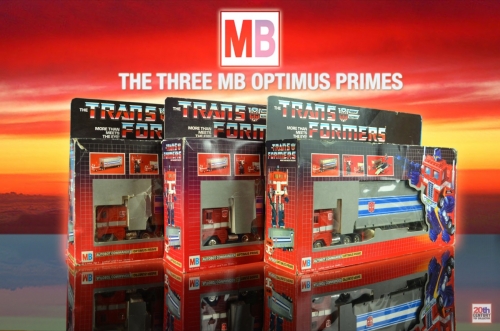
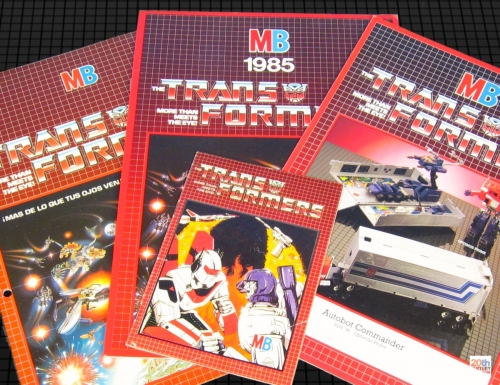
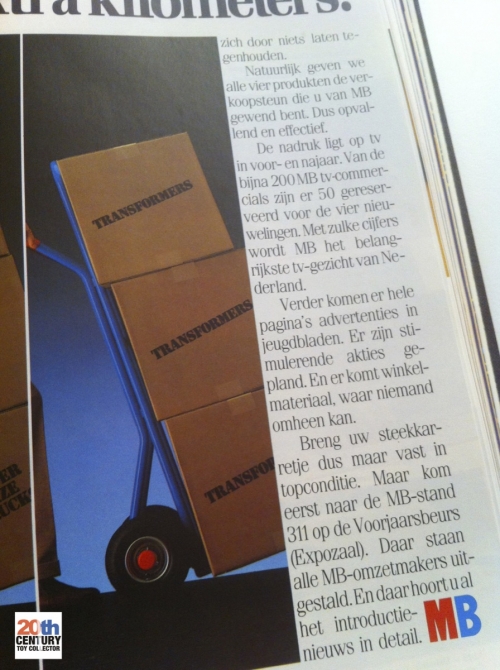
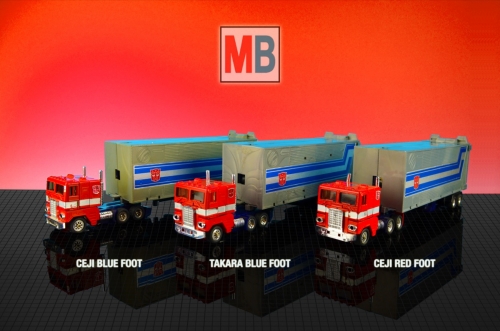
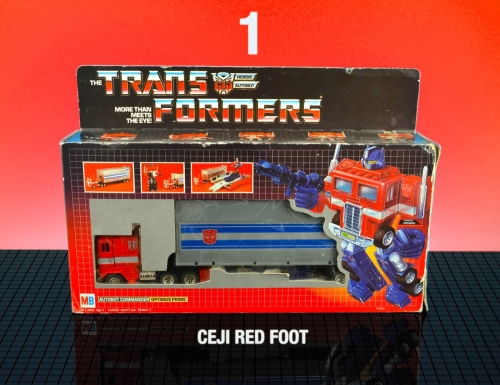
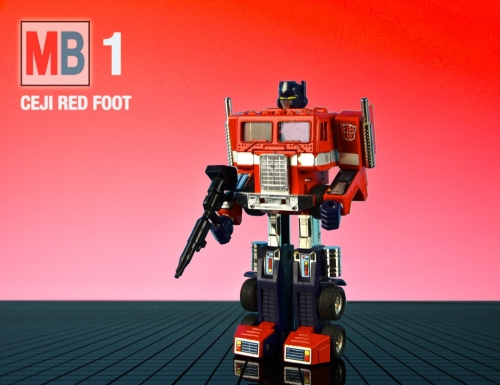
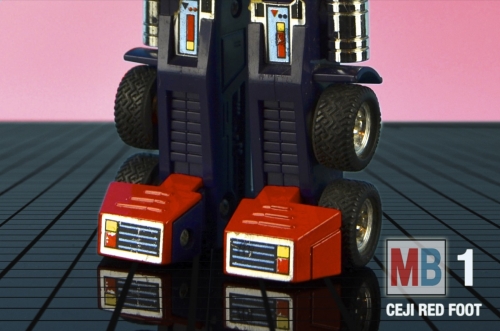
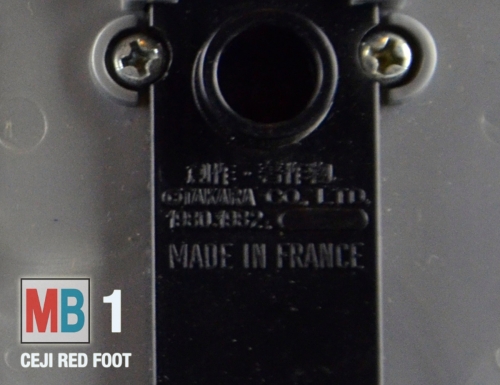
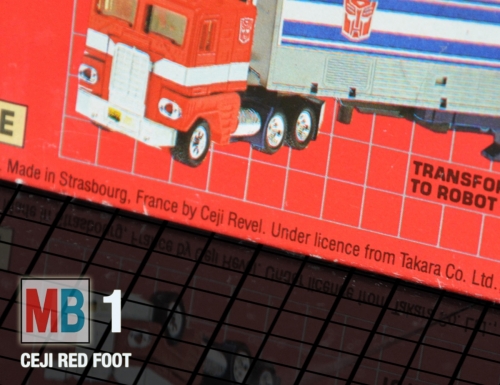
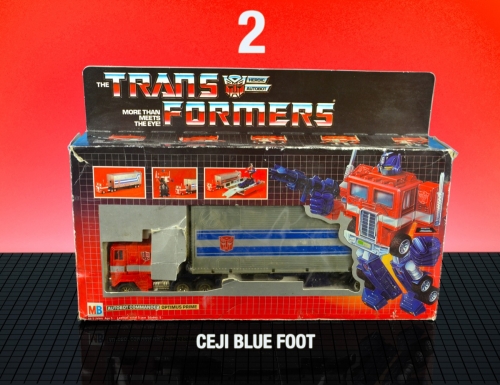
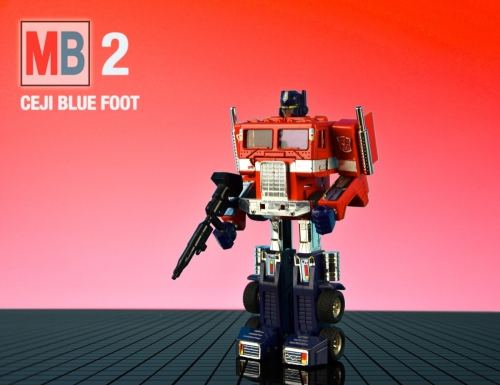
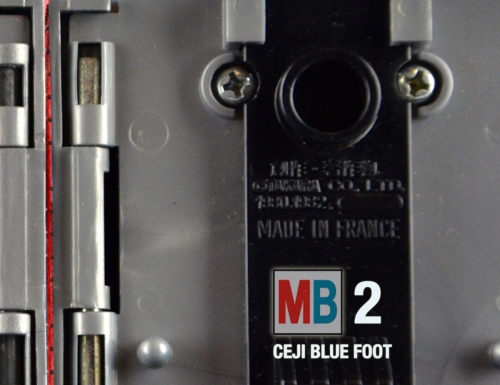
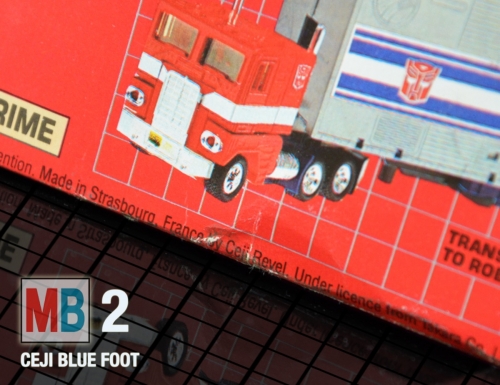
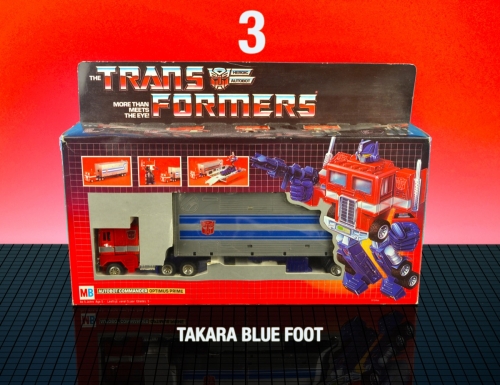
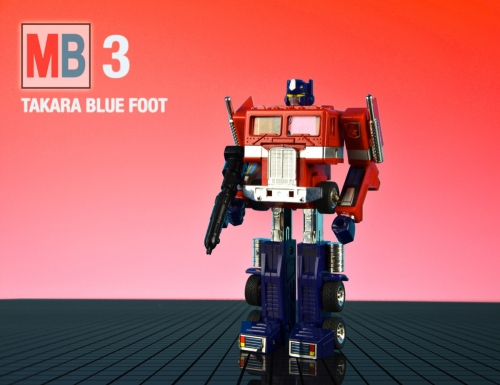
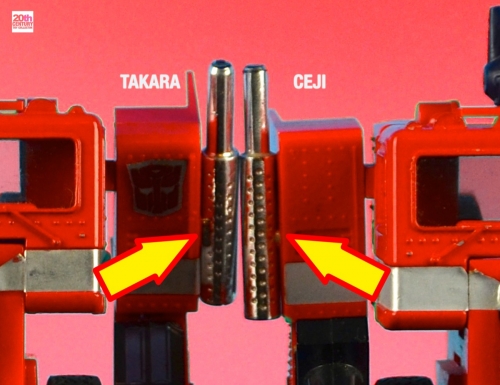
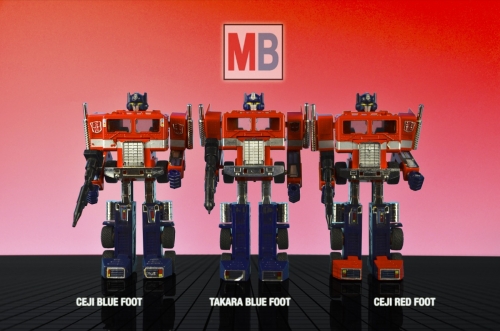
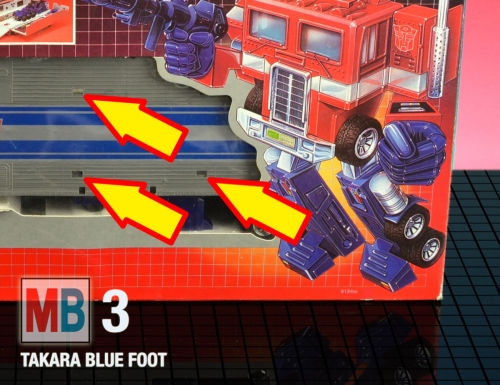
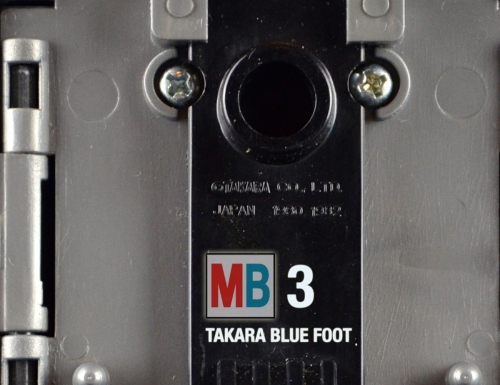
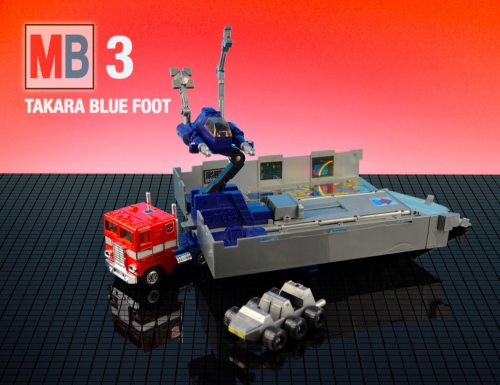
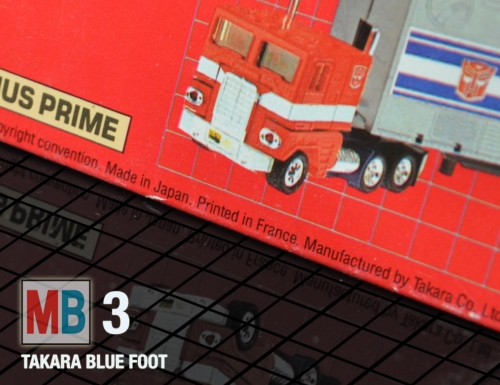
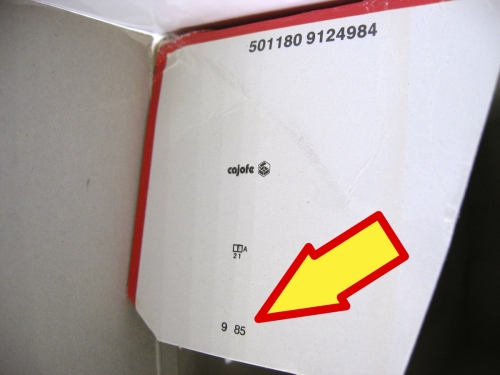
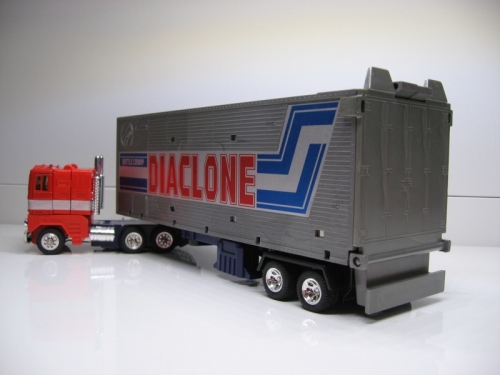
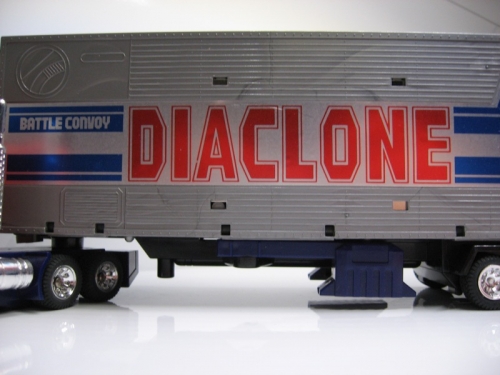
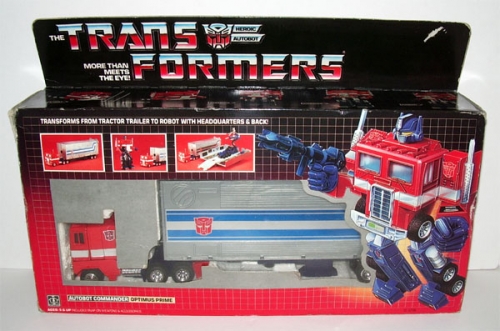
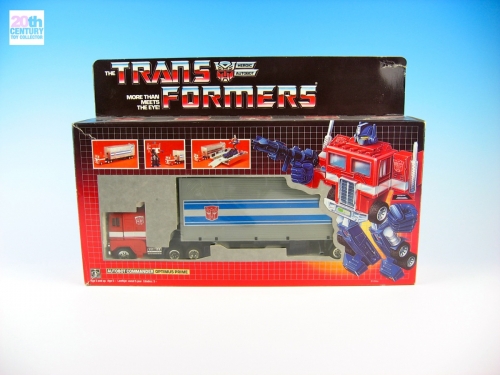
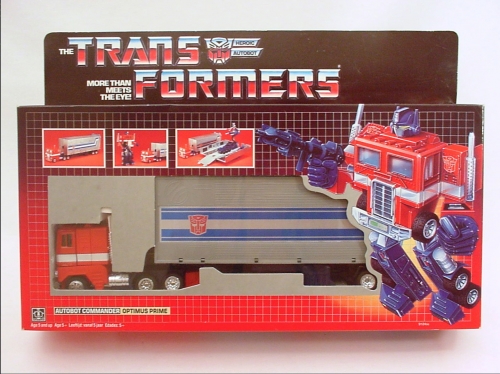
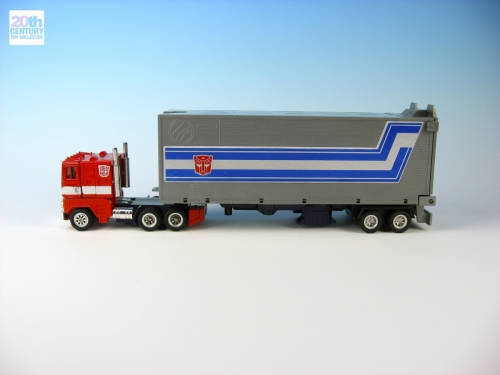
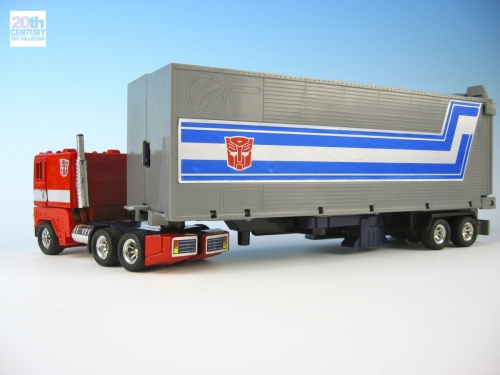
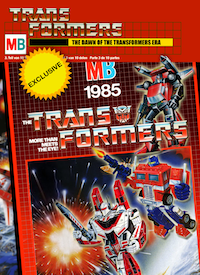
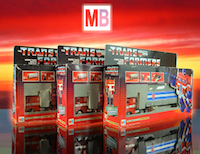
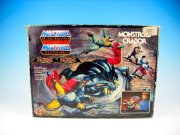
Great guide! I would certainly not mind owning a red foot OP. :-)
Dammit, now I want a red feet optimus….
Great article again, fun read!
LOL thx guys. That’s two more for the Red Foot Prime Appreciation Society! ;-)
Great guide – in addition Ceji blue feet optimus in hasbro box came out in New Zealand too due to the MB link. No red footed ones have turned up though.
Hi, just looked at my Ceji prime 5 86 on the box tab if your interested!
Cool, thx for the confirmation! Mine has the same date code.
EDIT: At closer inspection no it doesn’t. Mine has 4 86, but that’s the quad-lingual version (English, French, Dutch, Spanish). Is the one that you have with date 5 86 the same quad-lingual box or is it an all-English box?
Hi, all english box with the 5 86.
Thanks for the info. I always assumed the Ceji blue foot in all-English packaging would have the same date code as the quad-lingual Hasbro branded version, because the all-English (UK) red foot Prime’s box has the same date code as the quad-lingual MB Ceji red foot (9 85). I’m glad that’s cleared up and I am proven wrong. Thx again for that info!
…..
Now I wish I had a TARDIS-like time machine just to get BOT the red-footed Optimus Prime AND “Red” Tracks. :p
But besides that, loving your articles. :)
Thank you! And I guess every vintage toy collector wishes they had a time machine. Oh if only! ;-)
Hi, found out some more info – New Zealand was around 12 months behind the US with transformer releases with first sales being in early 1985. Optimus Prime was such a huge seller with unheard of Rain check numbers that Milton Bradley Hasbro NZ had to order additional primes and the only place that could fulfill these unexpected orders was the Franch distibutor.Hence the majority of primes sold in NZ in 1986 were from France. Which links back to my ceji prime being tagged 4 86 with the hasbro box. Man you don’t know how long it took to find that out!
@Prime Kiwi: Fantastic info! This seems to confirm the theory that one of the reasons why the Strasbourg, France production line (Ceji) was created was to keep up with the enormous new demand for territories outside of the US and Japan. Very cool. :-) Where did you dig up that info?
well that theory does make sense! Got this from a Milton Bradley Hasbro NZ employee who I made contact with only last week.
HI, I have been doing some research of my own on the Ceji Joustra “Made in France” Primes, and I have noticed some current sellers on the internet offering a prime with no silver paint on the three “blocks” (for lack of a better term) on the front of Prime’s helm – Instead, the blocks are blue, and appear to be unpainted. The seller’s claim these primes to be authentic, and they are advertising them as “Made in France” but I am curious, are these legit TF’s? Are these non-MB “Made in France” Prime’s, Knock-offs, or something else? Non of the three primes you have in this article appear to suffer from this “lack of manufacturer paint” on the helm.
Thank You!!
Hi, the Ceji Primes with both painted and unpainted blocks are genuine. They seem to have come in both variations. Here’s a link to an article of my good friend Maz on the red foot Prime:
http://www.tf-1.com/articles/eurous/redfoot_template.html
Half way down the article there are some photos where the unpainted forehead grill can be seen. Is that what you meant?
Yes, that is exactly what I was referring to! Great article by the way :) But now I am curious… unless I missed something in the article (I had to somewhat skim-through), is there an explanation for Prime’s painted/non-painted head grill variation?
I would assume it would have been rather inexpensive to apply this paint to the figure during the production process, especially since the rest of the grill is silver. I’m inclined to think this was a mistake, but is there any possible reason why they would have intentionally left the grill partially unpainted other than the obvious cost-cutting which is regularly employed by manufacturers?
I’m definitely intrigued and will have to conduct my own research, but any info you have would be great. And my apologies if there was an explanation in Maz’ article that I overlooked!
Thank you so much for these fantastic pages!!
Hi 20th C.T.C! Great site..
I bought a ceji blue foot prime in 2012 for $100.00 on
ebay. I would love to share pics with you and welcome your feed back let me know the best way to send those pics along…
Again what a site you have here cheers! Till are one!
Just hit me up at 20thtc@gmail.com. And thanks for the kind words! :-)
i dont know much about my 01 optimus prime… its hasbro takara 1980-1982…
I’ve been hunting for a Milton Bradley boxed Prime now for a little while. I missed out on one a couple months ago that you may have found interesting and it may answer one of your above questions. It was the metal plate Takara Prime, but it still had the Diaclone sticker on the front of the cab, in the license plate bracket. So it does appear that they actually re-stickered the old unsold Diaclone Joustra Convoys.
My hunt continues, but did score a Hasbro branded box red foot.
Great article. Any recommendations on how to assess value of Takara blue foot? I have had one sitting box since 2004, do not have original packaging. Complete and in great condition. rover is blue with black wheels. Black missiles are still in sprue.
The Australian TFs came from France through MB’s Australian distributor John Sands